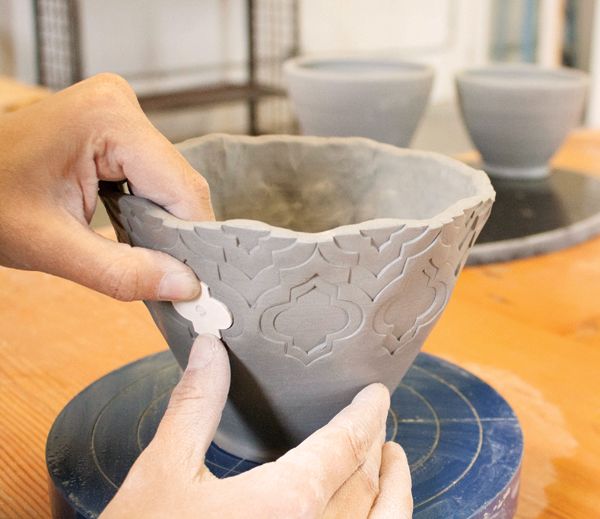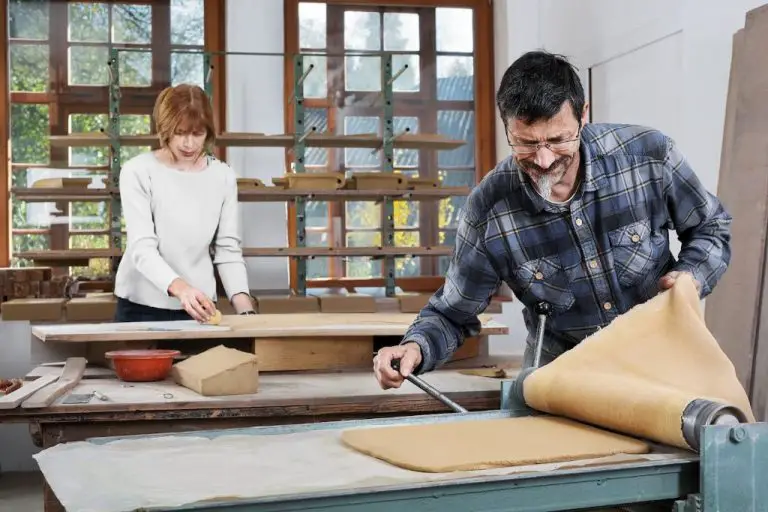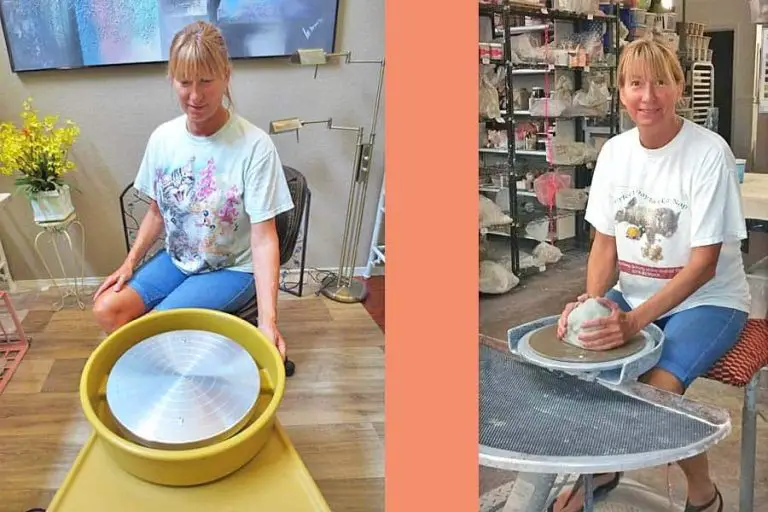How Do You Make A Hole In Clay Pottery?
Making holes in clay pottery can add function and aesthetic interest to a finished piece. Holes allow openings for attaching handles or spouts, hanging the pot from a hook or string, or providing ventilation. Decoratively, holes can become part of the overall design.
The process involves using the right tools to cut clean holes in leather-hard clay before firing. Proper technique prevents cracking or damage. Drilling holes in pottery requires care and precision but offers ample creative possibilities for the ceramic artist.
Gather the Necessary Tools
There are three common tools used to make holes in clay pottery: a needle tool, drill, or nail. Each has unique properties you’ll want to consider before starting.
A needle tool is a long, thin metal rod with a very sharp point on one end. Needle tools come in various diameters, such as 1/16″, 1/8″, or 1/4″. The sharp point can precisely pierce the clay. A needle tool is best for making very small holes.
A drill with a masonry drill bit can make larger diameter holes. Masonry drill bits come in sizes like 1/4″, 1/2″, or 3/4″. Choose a drill bit based on the desired hole size. Drills allow more control over the depth and diameter of the hole versus hand tools. Use a variable speed drill on the lowest setting.
A nail is a classic hand tool for making holes in clay. Use a nail with a sharp point and wide shaft. The shaft width will determine the hole diameter. Nails are good for quickly making rough holes, but do not allow precise control.
Determine the Size and Location
When making a hole in clay pottery, it’s important to first determine the desired size and location of the hole. Consider what the hole will be used for. Is it a drainage hole in the bottom of a planter or mug? Will it be used to thread rope through to hang the piece on a wall? Or is it for decorative purposes? The size and placement should align with the functional or aesthetic goals.
For a drainage hole, a diameter of 1/4” to 1/2” is typical. This allows water to flow out while still small enough to cover with a clay plug or tile. The hole should be centered in the bottom. For hanging holes, a diameter around 1/4” provides room for rope. Consider placing one or two holes near the top rim, equidistant from each other for balanced hanging.
Decorative holes can vary greatly in size and placement to achieve different artistic effects. Small holes in a pattern can mimic stars in the night sky. Large holes become negative space to complement the overall design. Holes along the sides add asymmetry. Determine hole size and location based on the desired look and purpose.
Make a Guide Indentation
Before drilling into the clay, it is important to mark the precise spot where the hole will go. This guide indentation serves multiple purposes.
First, it allows you to clearly visualize where the hole will be placed on the pottery and make adjustments if needed.
Second, it gives the drill bit a starting point and helps prevent the bit from slipping around on the clay surface.
Use a needle tool or nail to gently press an indentation into the clay at the desired location for the hole. The indentation should only be a few millimeters deep – just enough to guide the drill bit. Making a deeper guide hole by hand could risk the drill bit wobbling or cracking the clay.
The guide indentation should be a bit smaller than the intended finished size of the hole. For example, for a 6mm finished hole, the guide indentation may be around 4mm wide.
Take care not to press too hard when making the guide indentation or you could create an unsightly large divot in the clay surface.
Drill the Hole
Once you’ve made the guide indentation, you can start drilling the actual hole. For this step, you’ll need either a drill bit that’s suitable for ceramics and clay or a nail. Ensure you choose a drill bit or nail that matches the size of hole you want to make.
Hold the pottery firmly in place as you start drilling or hammering with the nail. Apply even, consistent pressure – don’t push too hard or tap too aggressively. Take it slowly and carefully. Ceramic and clay can crack easily if too much force is used. Keep the drill bit or nail perpendicular to the surface of the pottery as you make the hole.
Periodically stop drilling to check the depth and diameter of the hole. You want to drill just deep enough without going all the way through the base. The hole should match the specifications you determined earlier for its size and location. Don’t worry if the edges are a little ragged – you can smooth them later.
Check Depth and Diameter
Once you have finished drilling the hole, it is important to check that the depth and diameter meet the requirements for your project. Use a ruler or measuring tape to measure the depth of the hole. Compare this measurement against your desired depth. If the hole is not deep enough, you may need to continue drilling to reach the proper depth.
To check the diameter, find a cylinder, dowel, or other circular object that matches the required diameter. Insert this object into the hole. It should fit smoothly without excess space around the edges. If the hole is too wide, you may need to start over or plug it with clay and re-drill a smaller hole. Checking the diameter ensures your hardware, like screws or dowels, will fit snugly into the hole. This is essential for a secure bond when assembling the final piece.
Taking the time to confirm the hole’s depth and diameter will guarantee it meets the specifications for your project. This will lead to a strong, integrated finished product.
Smooth the Edges
After drilling a hole in clay pottery, the opened edges will be rough and uneven. This ruins the aesthetic appeal of a ceramic work and leaves a ragged, unprofessional appearance. Smoothing out the edges around drilled holes is a simple and critical process for ensuring a high-quality finished pottery piece.
Take a metal file or sanding sponge and gently rub it against the rough hole edges. Apply even pressure as you smooth away any uneven bits of clay around the hole perimeter. Work slowly and carefully to achieve a clean, polished surface that evenly transitions into the hole. Continue filing and sanding until all roughness is removed and the edges feel smooth to the touch.
Repeat this process for each drilled hole in your pottery work. Allow the smoothed clay edges to dry before cleanup and decorating. Filing and sanding provides clean openings that complement decorative finishes. Any glazing or painting will have a professional appearance around sanded holes without raggedy edges detracting from the design.
Clean Drill Bit Regularly
As you drill holes into clay, debris from the clay will build up on the drill bit. If this debris is allowed to accumulate, it can affect the performance of the drill. Clay particles can pack tightly around the bit, making the bit less effective at drilling clean holes.
To prevent this, it is important to regularly clean the drill bit. After every few holes drilled, take a moment to wipe the drill bit clean with a dry cloth or brush. Remove any compacted clay that has built up on the flutes or tip of the bit.
You can also periodically dip the bit in water to loosen stuck-on debris. Take care not to get water inside any electrical components of an electric drill. For hand drills, water can help lubricate and clean the bit while drilling.
Keeping your drill bit clean while drilling clay ensures consistent hole sizes and reduces wear on the bit over time. Taking just a minute to clean the bit periodically as you work can save frustration and improve the quality of your finished pottery.
Fire the Pottery
Firing is an essential step when making holes in clay pottery. The high heat from the kiln chemically seals and hardens the clay, including the edges of any holes. Firing vitrifies the clay, forming glassy compounds that fill in pores and smooth over rough edges. It also prevents the holes from getting larger or morphing shape when in use. The heat causes mineral fluxes to melt and flow over the clay surfaces. Glazes may also melt and coat the interior holes during firing.
Choose an appropriate peak temperature for firing based on the clay type, often between 1800-2300°F. The hole edges will become hard, durable, and less porous after slowly cooling in the kiln. Firing turns soft clay into a strong, finished ceramic material ready for use. So take care to fire adequately after holes are drilled to seal and set their shape permanently.
Apply Decorative Finishes
After firing, you can apply decorative finishes to your pottery to highlight the holes and make them a visually interesting feature. Here are some ideas:
-
Paint – Acrylic or craft paints work well on fired pottery. Paint the inside of the holes a contrasting color to the base color of the piece. Or paint concentric rings of color emanating out from the holes for an eye-catching effect.
-
Glaze – Dipping or brushing glaze over the piece and holes creates a glossy finish. Use a contrasting glaze color just on the holes. Or drizzle and drip colorful glazes randomly around the holes.
-
Stain – Using fabric dyes or wood stains are a good way to tint the clay around the holes. Cotton swabs help stain just inside the holes. Antiquing stains accentuate the edges.
-
Wax – Rub colored beeswax or paraffin into the holes to waterproof and give an interesting sheen.
-
Inlay – Inlay other materials into the holes for texture and color contrast. Materials like sea glass, beads, tiles, shells or pebbles add interest.
Get creative with finishes to make your holes stand out! The colors, textures, and shapes will enhance your final pottery piece.



